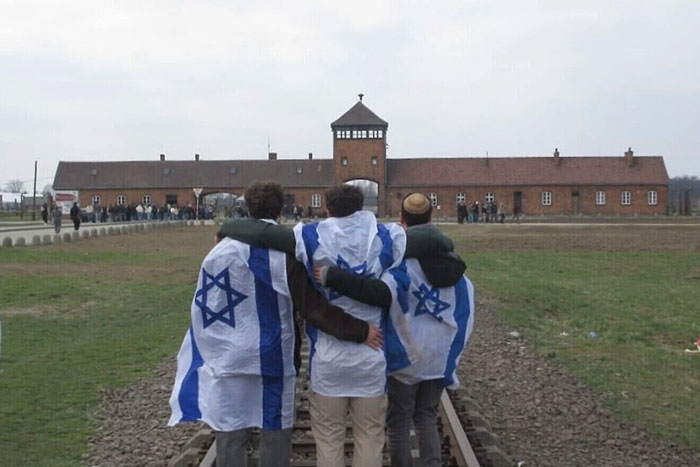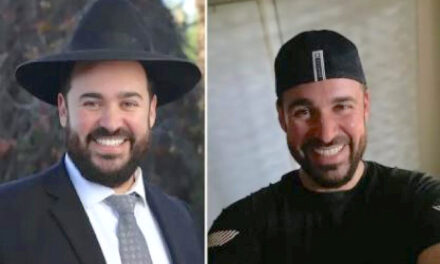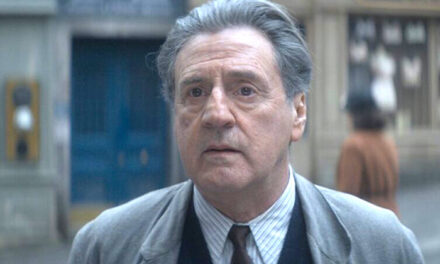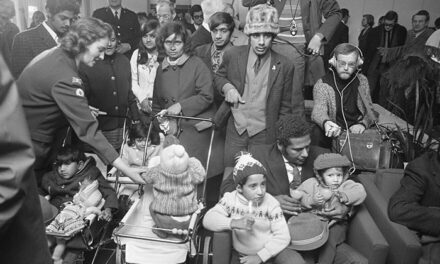Hillel Kofsky, right, on tour at the Auschwitz-Birkenau concentration camp grounds as part of a gap-year program in Israel, March 28, 2025. Courtesy photo.
JNS
I’m walking in a grassy field, surrounded by forest. I pass stones to my left, to my right; 17,000 stones in total. Other than the sounds of nature, the world here lies quiet and still, the trees stand tall—silent witnesses to horror. Some 800,000 Jews were killed on these grounds. Each stone represents a village lost. Each village sheltered thousands of Jews for generations. Now, not one remains. Everywhere I look, I see countless stones. How could this happen? How could God let this happen?
These were some of the questions I could not escape during a recent trip to Poland led by Jeff Seidel, who runs University Student Centers in Israel, for gap-year and Masa students in Israel. Our task was to bear witness to the Shoah and remind humanity of its lowest moments.
We Survive
Our first stop was Majdanek, a notoriously cruel concentration camp where some 100,000 Jews were murdered through starvation, forced labor or in the gas chambers. As we stood looking into one of those gas chambers, our guide shouted out: Shema Yisrael Hashem Elokeinu Hashem echad, “Listen Israel, God, our God, is one!” We stood in silence, listening as the declaration echoed across the chamber walls, honored to belong to the same nation. As our people met their end, these were perhaps the last words on their lips.
The next day, we solemnly read the infamous Arbeit macht frei, “Work makes you free” sign as we enter Auschwitz-Birkenau. Here lie memories of European Jewry: 100,000 shoes, 470 torn-off prosthetics. One particularly heart-wrenching sight was the seven tons of hair ripped from the heads of Jews. We watched videos of Jewish life before the war, images of observant Jews and children singing “Hatikvah,” Israel’s anthem of hope. We then looked through “The Book of Names.”
A project by Yad Vashem, Israel’s National Holocaust Museum, “The Book of Names,” documents the names of 4.8 million of the 6 million Jews slaughtered in the Shoah. I was aware of two relatives of mine, twins, who had been experimented on by Josef Mengele—the infamous figure who used Jews as guinea pigs. I didn’t know their first names, so I searched for their last name, “Weinstein.” I found seven pages of listings for about 1,700 people with the last name Weinstein. There were too many for me to search through in our time there, and they represent just a sliver of European Jewry that had been almost completely erased.
We stayed in Kraków, Poland, for Shabbat. According to Yad Vashem, 60,000 Jews lived in the city out of a total population of 250,000 before World War II. Today, it has only a tiny Jewish population.
After annihilating the Jewish people, it was said that Adolf Hitler had plans to build a museum to showcase all the art he had stolen from Europe and the Jews. Touring a museum in the Jewish quarter of Kazimierz—seeing displays of kippot, tzitzit and menorahs, all symbols of a lost world—I felt for a second that Hitler had partly succeeded.
Standing beside our group in this museum were Polish citizens and tourists from other countries. Amid feelings of sadness, I looked down and noticed my tzitzit. I touched the kippah on my head. Hitler had not succeeded; our nation was not lost forever. That Shabbat night, as many of the visiting Jewish groups joined for prayer and songs, we proved that we were stronger than ever. We sang for all the Jews who no longer could—raising our voices until they were hoarse and we could sing no more.
Remembering
After Shabbat, we boarded our tour bus for our next destination, but stopped seemingly in the middle of nowhere. After a short walk through pitch-black woods, we arrived at a gravesite. Here, our guides explained that 800 Jewish babies and children were shot by German Nazis and tossed into a pit. Surrounding the pit is a fence decorated with balloons, teddy bears and letters for the kids. Recently, people have also placed photos of hostages being held in the Gaza Strip and Israel Defense Forces soldiers who have been killed as a result of war in the wake of the Hamas-led terrorist attacks in southern Israel on Oct. 7, 2023.
We visited Treblinka and Warsaw on our final day and witnessed not just loss but courage. Treblinka was an extermination camp where more than 800,000 Jews were murdered. Now, nothing remains. On Aug. 2, 1943, the Jewish workers of Treblinka rebelled, attacking their guards and setting the camp ablaze. That act of bravery may have led to the camp’s closure.
Difficult Questions
“Where was God?” People ask about the Shoah, but I think it’s often to avoid the harder question: Where was humankind? As this tragedy was unfolding, the world stayed silent. After the Shoah, Jews remembered a long-forgotten truth: The only ones who can reliably safeguard us are ourselves. At Treblinka, the prisoners finally realized their only chance was to fight. In the Warsaw Ghetto, reminiscent of the famous last stand of the Jewish fighters of Masada against the Romans in 73 C.E., the Jewish rebels fought the Nazis until the very end. Their heroic last stand helped pave the way home after 2,000 years of persecution in exile.
Today, we are still threatened by those who wish us gone, as evidenced by Oct. 7. This time, though, we can protect ourselves. The Nazis didn’t care if we were left-wing, right-wing, religious or secular. Neither does Hamas. When visiting Poland’s lost communities, it felt at times as if their story ended there. But those communities and their inhabitants live on through us. And now, we must unite as Jews to carry our story forward. We fight. We celebrate. The trees remain silent, but this time, we speak out, and the proud flame of Jewish history continues.










